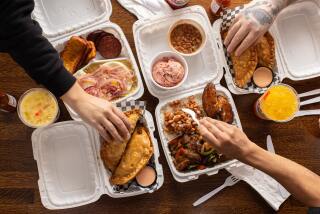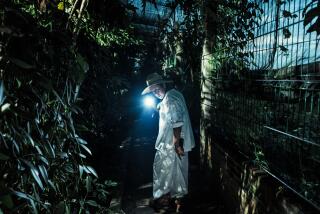Chugging With Your Chompipe
- Share via
Flor de Can~a, the sweet, golden rum produced in Central America’s finest distilleries, is a mainstay at drinking sessions in Nicaragua, in bars, in parlors and at any gathering of friends. A national drink, like Coca-Cola or tea.
But I never knew how important it might be to cooking until Thanksgiving 1986 in Managua.
It was the height of the war between Nicaragua’s leftist Sandinista government and the Contra rebels backed by the Reagan administration. Always an impoverished country, Nicaragua was suffering from the hardships imposed by U.S. economic sanctions and Sandinista mismanagement. Most foods were in short supply; grocery store shelves were bare. People were hungry.
Despite the difficult circumstances, my friend Marjorie Miller (now The Times’ bureau chief in Jerusalem) and I were determined to mount a Thanksgiving dinner. Thanksgiving was always my favorite holiday.
Would a turkey be possible? Meat and chicken were usually available only to people with connections to the government; a lucky few still owned a cow.
But deep in the countryside, we were told, there might be a turkey. Someone we knew knew someone who could get a chompipe--”turkey” in Nicaraguan Spanish.
Off we went and within a few hours, sure enough, we met our contact, who rounded up a small turkey. Squawking and flapping, it was carried back to our house-cum-office in Managua.
It was then that the time-honored tradition of Flor de Can~a came into play. It’s not what you might expect.
Our venerable cook, Don~a Carmen, did the honors. In Nicaragua, it goes like this: You ply the turkey with Flor de Can~a rum until it is completely drunk. Then you wring its neck.
And that is exactly what Don~a Carmen did. The reasoning is that the turkey dies happy, or at least feeling no pain, and that its meat is consequently more tender than if it were to die tense. That is what Don~a Carmen said.
So she cooked the turkey, and only when it was ready for serving did we realize that that poor turkey was much like the rest of Nicaragua: hungry. It was a scrawny specimen, looking more like a pigeon.
Fortunately, our guests that evening were mostly Nicaraguans and Britons in whose souls the Butterball experience was not ingrained. They were unaware of the grand carving-of-the-turkey ritual that they were missing. This poor turkey did not offer much to carve.
We supplemented the meal as best we could. Because we were foreigners with hard currency (i.e., U.S. dollars), we had access to the government-run, misnamed Diplomatic Store that featured an odd assortment of foodstuffs, clothes and electronic appliances. You could always get French pa^te and Pringles potato chips at this store, but never any basics.
At the Diplo Store, we found cranberry sauce and wine. In the regular market, we found carrots and a special treat: green beans. Don~a Carmen boiled these in bland but hearty style. Cabbage (a vegetable that survives all wars, I’ve learned) and Nicaragua’s famous green tomatoes were the salad.
Finally, our most filling dish was another Nicaraguan staple, gallo pinto. It is a mixture of the two items that remained available, if rationed, throughout the war: rice and beans. You cook black beans, then add them with their juice to frying onion. When the beans look fried, you add cooked rice (the proportions are roughly half beans, half rice) and mix.
And then, of course, we capped the meal with Flor de Can~a.
More to Read
Eat your way across L.A.
Get our weekly Tasting Notes newsletter for reviews, news and more.
You may occasionally receive promotional content from the Los Angeles Times.











